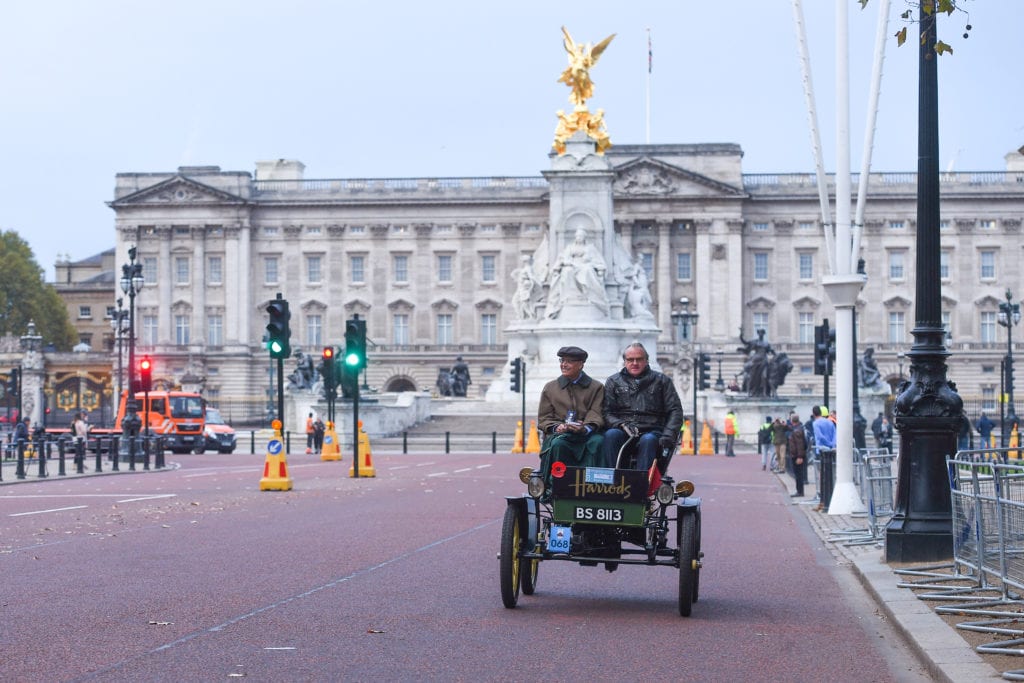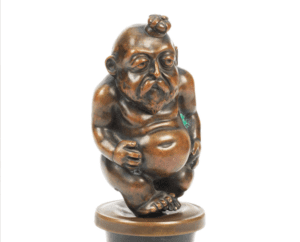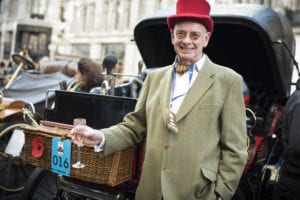Commemorating Automotive “Emancipation” on the 122nd Anniversary of the First Veteran Car Run

LONDON — A chilly predawn darkness enveloped Hyde Park Corner. The silence on the morning of last November 4 was pierced by an approaching car, then another, then many. Their engines went putt-putt, putt-putt, like idling lawn mowers.
Among them was a 1901 Pope Waverley, owned by Harrods, the venerable London department store. Its motor was electric and thus silent, unlike most of the others, and packed three horsepower, the same as the lawn mower I pushed as a kid. I would be riding in — hopefully not pushing — the car for the next eight hours.
Welcome to the 122nd Anniversary Veteran Car Run, the oldest continuing car event in the world. More than 400 Veteran Cars — built in 1904 or earlier — would try to traverse the 60-mile route from central London through villages named Cuckfield and Pease Pottage (really) to Brighton on England’s south coast. Those who made it to Madeira Drive on Brighton’s beachfront would be greeted with cheering crowds, chili (fun) and a glass of mulled wine (less fun).

We departed just after dawn, passing the Wellington Arch, Buckingham Palace, the Houses of Parliament and Big Ben: historic cars passing historic landmarks. Onlookers lined the route ahead. Some cars would break down. Those that didn’t would encounter the South Downs chalk hills just before Brighton. We removed the Pope Waverley’s canopy top to reduce wind resistance and make driving and hill-climbing easier. Rain wasn’t forecast, but who could tell?
“We’ve got to anticipate what’s going to happen like nobody’s business,” declared James Healy, the 52-year-old Harrods executive at the wheel — well, the tiller — of the Pope Waverley. Seemed a good idea for a long, cold trek in an old, slow car.
The Veteran Car Run (not a Race, mind you) is held every year on the first Sunday of November to re-create the first “Emancipation Run” in 1896. Okay, it wasn’t as historic as Lincoln’s Emancipation Proclamation. It marked the day when Britain raised its speed limit from four to 14 miles an hour, and scuttled its requirement that cars be accompanied by a flagman, running ahead and waving a red flag to warn of its approach.

“It was the starting gun for the motor industry in Britain,” explained Rupert Banner of the Bonhams auction house, principal sponsor of the Run, which was revived in 1927 and has been held most years since. “This event commemorates one of the major landmarks in the motoring world.” In short, cars were freed to be cars. Each year’s Veteran Car Run still begins with the ceremonial ripping of a red flag. Let’er rip, as it were.
The Run culminates the Royal Automobile Club’s London Motor Week. When I checked into the RAC, where I’m a member, a sign at reception stated the “dress code throughout the clubhouse will be relaxed to allow casual attire (no jacket and tie)” during the week. And “smart denim” and polo shirts would be allowed in the downstairs Long Bar. Talk about emancipation. This promised to be quite a ride.
THE FRIDAY AUCTION
I couldn’t attend the early Motor Week Events, so my first taste was the Bonhams Veteran Car Auction. It began midafternoon with the sale of ancient automotive memorabilia.
An “amusing bronze mascot” (aka, hood ornament) of King Edward VII proved just that. The circa 1907 statuette depicted the king, naked and potbellied, with a tiny crown atop his head. It was French (no surprise), from Edward’s favorite Parisian brothel, and sold for $2,041, with the buyer’s premium. God save the king.

A collection of 17 key fobs (non-electronic, of course) depicting St. Christopher, the patron saint of travelers, sold for $3,455. In the same religious vein, a book titled “A Catechism of the Motor Car” (1914) fetched a top bid of $285, as did a 1906 title, “The Romance of Modern Mechanism.” There was much, much more.
Following the memorabilia sale came a break for free champagne, which would lubricate the evening’s bidding. The auction of the cars — all certified “Veteran Car Eligible” — began at 6 p.m. Prices were posted on the electronic bidding board in British pounds, euros, U.S. dollars, Australian dollars, Indian rupees and Israeli new shekels. Sorry, no bitcoin.
Only 12 cars were being offered, the supply of Veteran cars being limited. I had imagined most attendees might be nearly as old as the cars, but not so. Andrew Johnson from Sussex, the south-coast county near Brighton, was just not quite 50. “As a boy, I used to watch the Run with my grandfather,” he explained.
He was hooked. Johnson made his first Veteran Car Run in 2007 as a passenger, and in 2014 he bought, at the Bonhams auction, his own veteran car: a 4.5-horsepower 1904 Phoenix Tricar, basically a big motorized tricycle.
“I get so much pleasure from the looks on people’s faces as my car goes by,” Johnson said. “I feel privileged to do this.”
The night’s lowest-price sale was a 1903 Rambler Model E 6.5HP Runabout, an ancestor of the American Motors Ramblers of decades later, which brought $60,690 with the buyer’s premium. At the high end, a 1903 Darracq Model JJ Rear-entrance Tonneau, from France, fetched $753,467, more than 10 times as much.

The difference: The Darracq has a 24-horsepower engine, the same as the Volkswagen Beetle 50 years later, which made it a speedster of its day. And it’s one of only two such Darracqs known to still exist and it competed in the 1903 Paris-Madrid Tour.
THE SATURDAY SHOW AND RECEPTION
That Saturday, Regent Street was closed to traffic — “pedestrianised,” in local parlance — between Piccadilly Circus and Oxford Circus for the Illinois Route 66 Regent Street Motor Show. As title sponsor, the Illinois Tourism Department was promoting trips along the historic highway, which begins in Chicago and slices diagonally to St. Louis before heading cross-country to Los Angeles.

Hawking tours of Old Joliet Prison and the Cozy Dog Drive In diner seemed a stretch in a country with the Tower of London, Windsor Castle and all the rest of it. But the English are polite, and the Illinois tourism tent drew visitors among the tens of thousands who jammed Regent Street.
The cars displayed included Jaguar XK120s and Mark Vs from 1948, marking their 70th birthday this year, making them mere tykes among the Veterans on the next day’s run. About 100 of those were present, including the Harrods Pope Waverley. Electric Waverleys were made from 1898 to 1914 (part of that time, the company was known as Pope Waverley). Thomas Edison owned one. So did William Horlick, who invented malted milk.

The Harrods Pope Waverley first made the Veteran Run in 2013, said Len Brown, the company’s curator of historic vehicles, himself historic and well preserved at age 83. Clad in his Harrods moss-green goatskin-suede doorman’s coat, Brown eagerly explained the Pope Waverley’s mechanical workings.
It uses four 12-volt batteries, which we’d change at least twice en route to Brighton. Spare sets would follow in Harrods vans. The Pope Waverley, which was built in Indianapolis, has no ignition switch. The driver just puts the car in a forward gear, removes the stick that keeps the brakes engaged, and off it goes. Well, crawls; the car cruises at 10 mph, hitting 15 down hills.
It has pneumatic tires (amen) mounted on wooden wheels, which evoked a joke about the early American Brush Runabout: “Wooden frame, wooden axles and wouldn’ run.” But the Pope Waverley had never failed to finish the Veteran Car Run, even after its main brakes gave out halfway to Brighton last year. (The emergency brake sufficed.) I hoped that record would remain intact.

Those admiring the Pope Waverley included Paul and Tracie Kelling from Sudbury, 70 miles northeast of London. They would make the Run in their 1904 curved-dash Oldsmobile, which Paul sometimes drives through the local McDonald’s — quite a feat without cupholders. The five-horsepower Olds had successfully completed four previous Veteran Runs. “It’s all about just getting there,” explained the 54-year-old Kelling, owner of an industrial-pipe company.
On Saturday night, Harrods, a principal sponsor of the Veteran Car Run, hosted a glittering reception for participants and notables at the Royal Automobile Club. At one point, the gurgle of pouring champagne was drowned out by a buzz signaling that someone important had arrived.
Was it Sir Jackie Stewart, perhaps, or Prince Charles? No and no. It was Alan Titchmarsh, Britain’s top celebrity gardener. It’s big, like being a celebrity bull rider in Texas. The Harrods people on hand were totally chuffed. (Not to worry; the term means “pleased.”)
I ducked out early for bed. Tomorrow would bring an early start and a long day.

SUNDAY, THE VETERAN CAR RUN
In 1896, a Harrods Panhard et Lavassor delivery vehicle was one of the 33 vehicles in the first Emancipation Run. Later, the company bet on electric vehicles and assembled a fleet of them — perhaps a few years early. The company’s participation in the Run was sporadic. It restarted in 2013 with the refurbished Pope Waverley.
Our starting time was 7:11 a.m., but I arrived at 6, grabbing coffee and waiting in the dark. We were assigned starting position 68. Later-model cars get later starting times because they’ll pass (“overtake,” over here) the earlier cars en route. The difference between the oldest car making the run, a 2.5-horsepower 1893 Peugeot, and the various 20-plus horsepower 1904 cars is like the difference between a Commodore 64 and an early Macintosh.

James Healy, Harrods’ store-operations chief, appreciates the Veteran Run’s promotional value, but as a motoring enthusiast (his small collection includes three Porsche 911s), he simply likes making the Run. At least most years. In 2014, rain drenched the route. Len Brown’s goat-suede Harrods doorman’s coat was two inches longer at day’s end. At one point, James reached into his pocket for his glasses and pulled out a fistful of water. “This is one of the most eccentric automotive events,” he says as we start. I’m convinced.
For now, the skies are clear and the temperature is a (relatively) balmy 45 degrees. Many participants don period dress; my plaid jacket, club tie, Burberry trench coat and newsboy cap are a game, but lame, try. Soon we see a couple of stalled cars, which their drivers try earnestly to revive.

There are two routes at the start, Red and Blue. No, this isn’t like Red States vs. Blue States. It’s to spread things out in central London. Cars with odd-numbered starting positions get the Red route, and the even numbers like us get the Blue, before the two merge south of the city. Good idea, since we’re sharing the road with modern cars, everything from Renault Clios to Audi A8s. In any collision, we’d lose. A driver was killed in the 2017 Veteran Run. It was a rare, freak accident, but memories remain raw.
Crossing the Thames into Vauxhall , we head toward London’s southern suburbs. The crowds, sparse at first, grow larger. The cheering onlookers are fortified with hot coffee and tea. Later their fortification would change to beer and wine, mulled or otherwise. The steam-powered cars (there are several) pull over for a coal-and-water injection. Around 10 a.m., we remove the batteries and put in a new set.
The temperature is climbing toward the mid-50s, so I won’t be bragging about enduring cold rain or icy sleet. But I’m cold enough, thanks, and appreciative that Len has brought a wool blanket to gird our lower legs. James wonders aloud whether the workers who built the Pope Waverley imagined it would still be running, and applauded, 117 years later. I think, ruefully, that my own life’s work won’t leave such a legacy.

Around noon, I take a break and hop into one of our trailing vehicles, a late-model Mercedes-Benz V220d van. Heater! Headrest! Heated seat! Veteran it isn’t. The crowds are swelling now. One group of neighbors has pulled furniture to the roadside, and is partying and cheering us on. In the village of Handcross, just past Pease Pottage, fans in black tie have commandeered a pub. “Well done! Good running!” they shout, at a decibel level suggesting they are refueling more often than the cars.
At 1:15 we make a second battery change, and I leave the Mercedes to re-enter the Pope Waverley. James hopes these batteries will get us all the way to Brighton, a big improvement over some past years, when up to six battery changes were required due to colder, fouler weather. Around 2 p.m., the South Downs come into view. Now things will get serious.
The South Downs top out at just 900 feet, but the climb is always touch-and-go for the Pope Waverley. I offer to get out and walk if necessary — hoping, of course, it won’t be. And once over the hills, we must merge onto the A23 motorway, amid modern cars travelling at freeway speeds.
As the climb begins, the Pope Waverley slows, leaning into the slope, it seems. I lean forward in my seat, a gesture more sympathetic than effective, I suspect. We come to the Clayton Railway Tunnel, with its iconic castle-front entrance.
“The worst is over,” says James, as he hops out of the Pope Waverley and into the comfort of the Mercedes van, letting Len drive the last six miles into Brighton. It’s a generous gesture and a good marketing move, as Len cuts a distinct figure in his Harrods coat and cap.

But the worst isn’t quite over. As the A23 comes into sight, the merge into rushing traffic looks intimidating, especially because we have to slide over two lanes to keep on our route. “Indicate, indicate,” barks Len. It takes me a few seconds to realize that to “indicate” means to deploy your turn signal, which in the Pope Waverley happens to be my right arm. I gingerly comply.
To me, Brighton’s crawling city traffic is frustrating, but to Len it’s showtime. He beams as Sunday shoppers wave at him and the Pope Waverley, which has required just two battery changes and has kept its six-year record of finishing the Run intact. In fact, only about 15% of the starting cars didn’t finish the 2018 Run, thanks to the dry and mild (for an English November) weather.
Among the finishers were the Kellings, Paul and Tracie, in their McDonald’s-proven, 1904 curved-dash Olds. They won the Regularity Time Trial Award for strictly adhering to a target speed of 12 mph over a designated part of the route, covering the 13 miles at 12.05 mph. (Calls for a Quarter Pounder with cheese, perhaps.) “We had a good run down in the fastest time so far, 4 hrs 50,” Tracie wrote in a follow-up email. “Hope you made it as well.”

Indeed, though our time of eight hours and four minutes was much slower, attesting to the rapid technical progress of cars between 1901 and 1904. But that didn’t dim the luster of driving along Madeira Drive, past thousands of cheering onlookers, between the city’s resort hotels and its famed beachfront.
We picked up our award pennant “for punctual arrival in Brighton” but skipped the mulled wine to beat traffic out of town in the Mercedes van, which I counted as a win-win. The heavy Sunday-afternoon traffic back to London testifies to the ultimate success of the Pope Waverley and its contemporary cars.
But before departing, I met another driver in a 1904 curved-dash Olds: Juan Molinari of Rosario, Argentina. “This is a world event,” said the 71-year-old Molinari, a retired broadcasting executive, whose very presence proved his point. “There is no other opportunity where you can watch and see so many Veteran cars. This is high-quality time.”
Made a comment